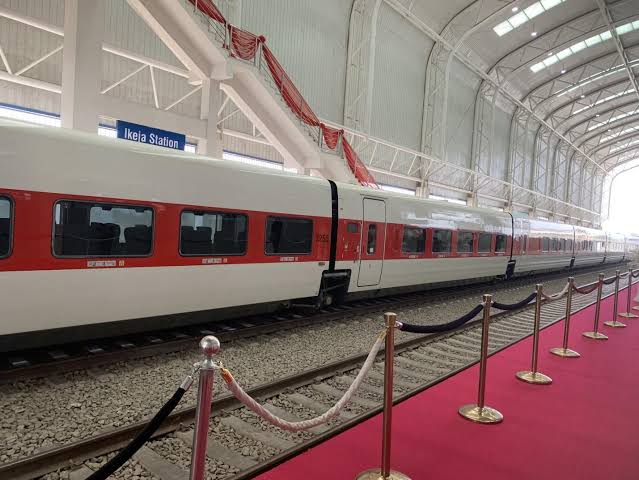By the time we made a stop at Agege, some of my colleagues wondered how we got there. For sure, because of the usual busy roads in Lagos, it will take at least 20 minutes to drive from Airport Bus stop on the Agege Motor Road to Pen Cinema, a major bus stop in Agege. It wasn’t because we didn’t know that the distance was not long, it was simply because of the quiet and conducive ride which the train provided.
I’m not sure it was up to five minutes. What’s more, officials of the Lagos Metropolitan Area Transport Authority (LAMATA) provided an insight. The Red Line we were travelling in was even very slow as it did just about 25km per hour.
Brought from Milwaukee, Wisconsin in the United States, the train can do nearly 300km an hour. This metro does not have the stretch since it must stop at stations along the Agbado-Oyingbo railway, which the Babajide Sanwo-Olu administration started and completed.
Despite the “slow” movement, the line was in Iju and later Agbado (geographically in Ogun State), within 20 minutes. We made the three stops and waited a bit longer at Agbado for the Nigeria Railway Corporation’s inter state train to pass.
For us, it was a pleasure seeing Lagos through the windows of the Red Line. Seeing the neighbourhoods, reminiscing the old days for those who had lived in the axis.
For me, I loved seeing all the traffic points looking powerless so to speak. We glinted through in a manner of speaking making flying seem less opportune.
At Agbado train station, the place called Agbado crossing holds memories. I recall taking a route once there when there was a complete blockade many years ago on the Lagos-Abeokuta Expressway. I was in Ijaiye, the only option was to get to Agbado crossing in order to connect Iju, Ishaga, Fagba, then Agege.
To have gone back without steering a vehicle in such a smooth ride makes me jealous of the commuters that would be using this service on a daily basis in the next few weeks. They don’t know the joy, and the burden that th governor and his team have taken off them by the provision of this world class infrastructure.
The Red Line is not just about the convenience or comfort, but the cheaper cost that this mode of transportation will become for commuter. Market women, for example, who go to Oyingbo early in the morning to buy stock may take their time now because they are assured of fixed departures and arrivals for train rides when commercial operations begin. It is the same for civil servants, other workers, business people and other category of residents going about their daily businesses. Lagos residents could not have asked for better. It is even more fitting that in a little while, more trains are being awaited from China.
The 37-kilometre rail line, built by LAMATA, has seven stations covering Lagos West and Lagos Central senatorial zones including at least 10 Local Government Area/Local Council Development Areas.
The facilities of the Red Line are of modern repute. These include the train’s cooling system, handrails, cushioned seats, and in-built safety features. The stations are spacious and well situated to drive home the inter-modal transportation model as there are BRT terminals situated close to the train stops.
Also, the stations are well secured to guarantee premium safety for all passengers and tourists. Of course, the mode of payment remains only the Cowry card; the same one you use for your BRT or LAGFERRY rides.
For the train tracks, there is also continued enforcement to clear the railway of unauthorised activities and pedestrian interference.
The Red Line train is part of the Lagos Rail Mass Transit infrastructure, which aims to provide an integrated transportation system for the state. The project includes the construction of four bridges along the rail corridor, with all flyovers already inaugurated – further reducing vehicular intrusion.
The eight stations in the corridor are Agbado, Iju, Agege, Ikeja, Oshodi, Mushin, Yaba and Oyingbo in Lagos Central.
The Red Line train project is expected to alleviate traffic congestion and provide a convenient transportation option for residents. With its inauguration, Lagos is one step closer to achieving its goal of becoming the megacity with a world-class transportation system, all thanks to Sanwo-Olu and those that came before him.

